Physical Address
304 North Cardinal St.
Dorchester Center, MA 02124
This chapter discusses a range of inflammatory and other nonneoplastic diseases of the pancreas, with a focus on variants of chronic pancreatitis that mimic pancreatic neoplasia including autoimmune pancreatitis (AIP) and paraduodenal pancreatitis. In the past, a generic diagnosis of chronic pancreatitis was often sufficient, but with the recent recognition of unique variants, some steroid responsive, the pathologist is required to further subclassify this disorder.
A brief review of the pancreatic duct system is in order before a discussion of pancreatitis. The anatomy of the pancreatic ductal system is unpredictable because of developmental variability. The main pancreatic duct, the duct of Wirsung, carries the bulk of pancreatic secretions and drains into the duodenum at the papilla of Vater. The accessory pancreatic duct, also known as the duct of Santorini, drains into the duodenum through a separate minor papilla that is typically 2 cm cephalad to the papilla of Vater. In most individuals, the accessory pancreatic duct is nonfunctional. The minor papilla may appear as a nodule in the second part of the duodenum, and the endoscopist could mistake this for a polyp. Histologically, the relatively narrow accessory pancreatic duct is accompanied by pancreatic acinar and occasionally endocrine elements, which are often found within the submucosa of the duodenal wall.
Acute pancreatitis is an inflammatory disease of the pancreas that is characterized clinically by acute abdominal pain and elevated serum amylase and lipase. , The incidence of this disease has increased in the past two decades, and acute pancreatitis accounts for more than 200,000 hospital admissions every year in the United States. Eighty percent of these episodes are mild and resolve without serious morbidity, but in 20% of cases, the episodes are more severe and are associated with substantially increased morbidity and mortality. , Although frequently encountered at autopsy, acute pancreatitis is seldom seen by the surgical pathologist. In rare instances, pancreatic neoplasms could present as acute pancreatitis, and microscopic foci of resolving acute pancreatitis may be seen adjacent to neoplasms of the pancreas.
There is a wide spectrum of severity, with some episodes of acute pancreatitis being mild and self-limited, requiring only brief hospitalization, and those most severely affected developing persistent hypovolemia and multiorgan dysfunction. The diagnosis of acute pancreatitis requires at least two of the following three features: (1) abdominal pain, (2) serum lipase and/or amylase levels at least three times that of normal, and (3) evidence of acute pancreatitis on imaging. ,
The two most common triggers of acute pancreatitis, obstruction of the common bile duct by stones and alcohol abuse, together account for approximately 80% of cases of acute pancreatitis in Western countries ( Box 40.1 ). , Bile stone–induced pancreatitis typically affects elderly women and is caused by gallstone migration and subsequent pancreatic duct obstruction. Although gallstones are the most common cause of biliary obstruction, other forms of obstruction, such as periampullary tumors and neoplasms involving the head of the pancreas, may also provoke acute pancreatitis. Alcohol-related acute pancreatitis is more frequently seen in middle-aged men. Experimental studies have implicated alcohol in transient increases in pancreatic exocrine secretions, direct toxic injury to acinar cells, and contraction of the sphincter of Oddi. However, the relationship between alcohol and acute pancreatitis is not completely understood because acute pancreatitis develops in only a small fraction of patients who abuse alcohol. Clearly, other genetic and environmental factors play a major role in the development of alcohol-related acute pancreatitis.
Alcohol ∗
∗ Alcohol and bile stones are the two most common causes of acute pancreatitis.
Cigarette smoke
Drugs: valproate, phenacetin, thiazide, estrogen, and azathioprine
Gallstones ∗
Pancreatic neoplasms
Hypercalcemia, hyperparathyroidism
Hyperlipidemia, lipoprotein lipase deficiency
Chronic renal failure
HIV, mumps virus, coxsackie-virus
CFTR mutation
PRSS1 mutation
SPINK1 mutation
CTRC mutation
Autoimmune pancreatitis (rare)
After transplantation
After irradiation
Vascular disease: atheroembolism
Tropical pancreatitis
Drugs appear to account for about 5% of all cases of acute pancreatitis. The drugs most often associated with this disorder include azathioprine, 6-mercaptopurine, valproic acid, angiotensin-converting enzyme inhibitors, and mesalamine.
In a substantial minority of cases, the cause of acute pancreatitis is unexplained. Genetic testing for mutations, including the cationic trypsinogen (PRSS1), serine protease inhibitor Kazal type I (SPINK1), or cystic fibrosis transmembrane conductance regulator (CFTR) gene, may provide an explanation for recurrent acute pancreatitis because these may provide cofactors that precipitate acute pancreatitis (see later discussion).
Although the precise pathogenesis is controversial, it is nonetheless believed by most investigators that acute pancreatitis is caused by unregulated activation of pancreatic trypsin, and this enzyme leads to both autodigestion and local inflammation. After activation of trypsinogen to active trypsin, other pathways and enzymes in the pancreas such as elastase, complement, and kinin systems are activated. The inflammation is further propagated by the production of mediators such as interleukin 1 (IL-1), IL-6, and IL-8, which are produced by neutrophils, macrophages, and lymphocytes that are attracted to the diseased pancreas.
The pancreas typically appears swollen and pale. With mild acute pancreatitis, multiple tiny spots of opaque white fat necrosis are seen on the surface of the pancreas ( Fig. 40.1 ). The amount of intrapancreatic fat varies considerably among individuals, and the presence of intraparenchymal fat necrosis is appreciable only in those with a moderate amount of intrapancreatic fat. In cases of severe acute pancreatitis, confluent areas of necrosis and hemorrhage are identified.
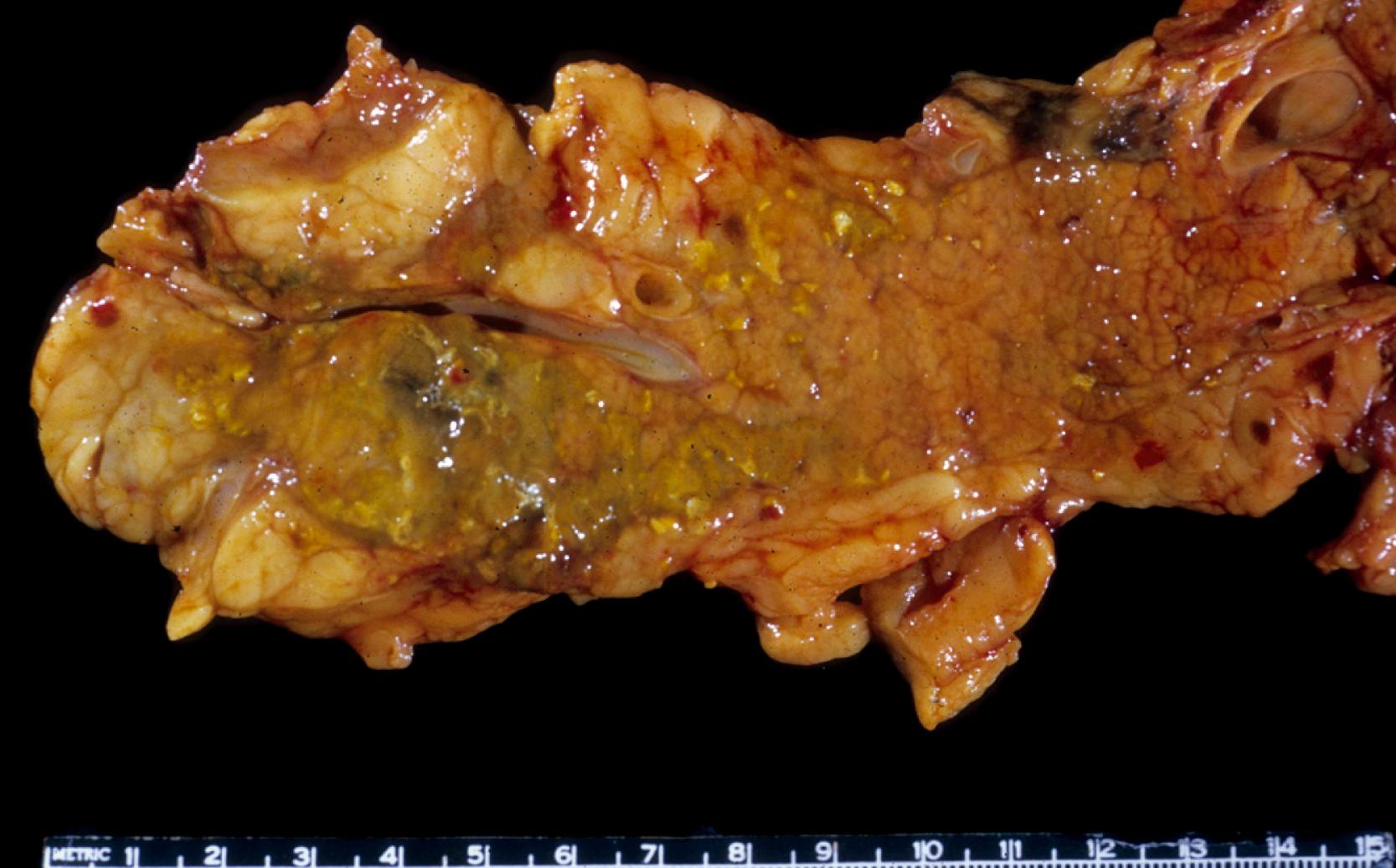
Histologically, the changes of acute pancreatitis are best characterized in autopsy material. In mild forms of acute pancreatitis, the disease is concentrated in the interlobular septa. With time, these foci of fat necrosis are replaced by foamy macrophages and, ultimately, by fibrosis ( Fig. 40.2 ). In the more severe examples of acute pancreatitis, there is diffuse necrosis involving the acinar and ductal tissue accompanied by acute inflammatory cells. Infected acute pancreatitis is associated with high mortality. Damage to the vasculature results in diffuse hemorrhage (hemorrhagic pancreatitis). Well-characterized examples of acute pancreatitis triggered by atheroembolism have also been reported.
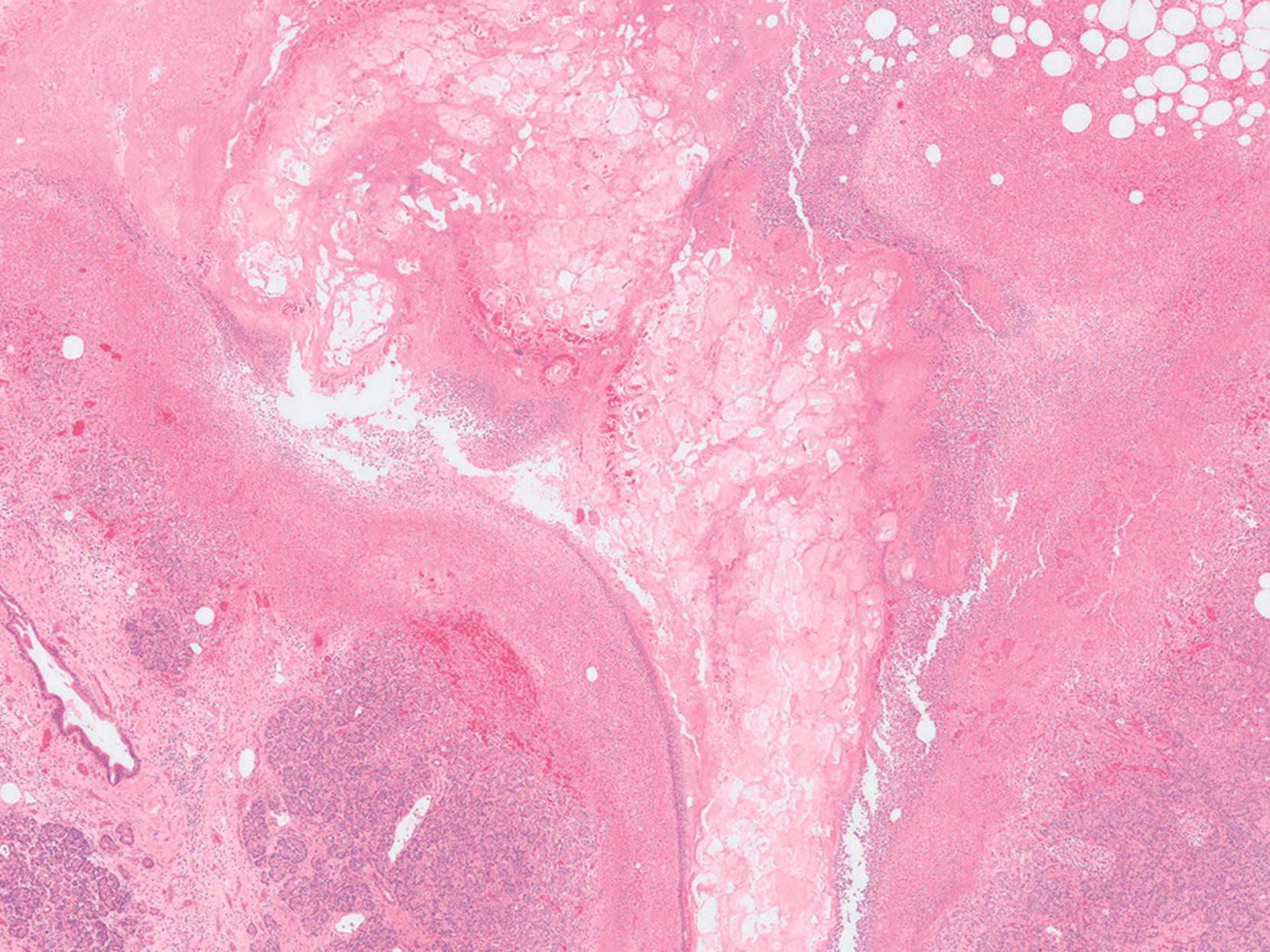
The treatment for mild forms of the disease is largely supportive and includes fluid resuscitation. , More severe cases require aggressive fluid resuscitation and antibiotics.
Chronic pancreatitis is a fibroinflammatory disorder in which the pancreatic acinar compartment is replaced by fibrosis, eventually leading to exocrine insufficiency.
The annual incidence rate ranges from 5 to 14 per 100,000 individuals, and the prevalence ranges from approximately 30 to 50 per 100,000 individuals. Recent studies seem to indicate an increasing incidence of chronic pancreatitis. The median age of patients ranges from 51 to 58 years. Chronic pancreatitis is up to five times more common among men than women.
Patients with chronic pancreatitis typically show steatorrhea, diabetes mellitus, and pancreatic calcification on abdominal imaging. However, these diagnostic criteria are insensitive in the early phase of the disease and are fulfilled only when the pancreas is essentially destroyed. Pain is often the leading symptom in patients with chronic pancreatitis.
The diagnosis of chronic pancreatitis typically involves: (1) recurrent bouts of abdominal pain with or without greater than threefold elevation of amylase and lipase levels, (2) radiological evidence of strictures and dilation of the pancreatic duct and branches with or without calcification, and (3) histological proof of chronic pancreatitis, typically in the form of endoscopic ultrasound (EUS)-guided biopsy.
A number of classification schemes for chronic pancreatitis have been proposed, including the Marseille classification of 1963, the revised Marseille classification of 1984, the Marseille-Rome classification of 1988, the Cambridge classification of 1984, the Zurich classification of 1997, and the Japan Pancreas Society classification of 1997. However, there is no single widely accepted system, and most of these schemes are not helpful in clinical practice. Furthermore, many of them focus on the distinction between acute and chronic pancreatitis and pay little attention to histopathological changes; hence they are of limited interest to the anatomical pathologist. Of note, the composition of the inflammatory infiltrate and the pattern of fibrosis provide clues to the etiology of the disease.
Etiological factors include toxic metabolic injuries such as those caused by alcohol abuse, tobacco smoking, hypercalcemia, hyperlipidemia, medications, and other toxins. The most common cause of chronic pancreatitis in developed nations is alcohol ingestion, which accounts for approximately 70% to 95% of cases ( Box 40.2 ).
Alcohol and tobacco
Paraduodenal pancreatitis
Autoimmune pancreatitis
Tropical pancreatitis
Hereditary pancreatitis
Cystic fibrosis–related pancreatitis
The pathogenesis of chronic pancreatitis is not well defined, although five mechanisms have been implicated in the development the disease : (1) the necrosis-fibrosis sequence argues that chronic pancreatitis develops through multiple episodes of acute pancreatitis, (2) the sentinel acute pancreatitis event that advocates the chronic pancreatitis is triggered by a single attack of acute pancreatitis, (3) the direct toxic metabolic effect is caused by environmental factors, most typically alcohol and tobacco, (4) free radicals contribute to oxidative stress and the expression of transcription factors and release of cytokines, and (5) ductal dysfunction occurs, leading to protein plugs and ductal obstruction. Pancreatic stellate cells are activated and play a critical role in the development of fibrosis.
The hallmark of chronic pancreatitis is fibrosis, although in the early stages it may be unevenly distributed. Most surgical specimens show diffuse fibrosis and significant induration. The gland may appear enlarged, but in the late phase of the disease the pancreas is shrunken. Cysts of varying sizes are identified both within and outside the pancreas. The extrapancreatic cysts invariably represent pseudocysts; the intrapancreatic cysts are either pseudocysts or retention cysts. Another hallmark of alcoholic chronic pancreatitis is calcification, both within the main pancreatic duct and in the parenchyma. The main pancreatic duct may be obstructed and dilated, although strictures may also be identified. Tapering stenosis of the common bile duct is present in a minority of cases.
Histologically, alcohol-related pancreatitis exhibits varying degrees of atrophy of the exocrine and endocrine components along with calcification and fibrosis ( Fig. 40.3 ). In the late phase of the disease, overt interlobular fibrosis is seen, and intralobular fibrosis is also invariably present. The fibrosis is relatively acellular, but occasional fibroblasts and myofibroblasts are seen. Although much of the acinar component may be depleted, foci of well-preserved acinar tissue are seen interspersed. Some of the pancreatic ducts are dilated; they are filled with proteinaceous material and sometimes calculi ( Figs. 40.4 and 40.5 ).
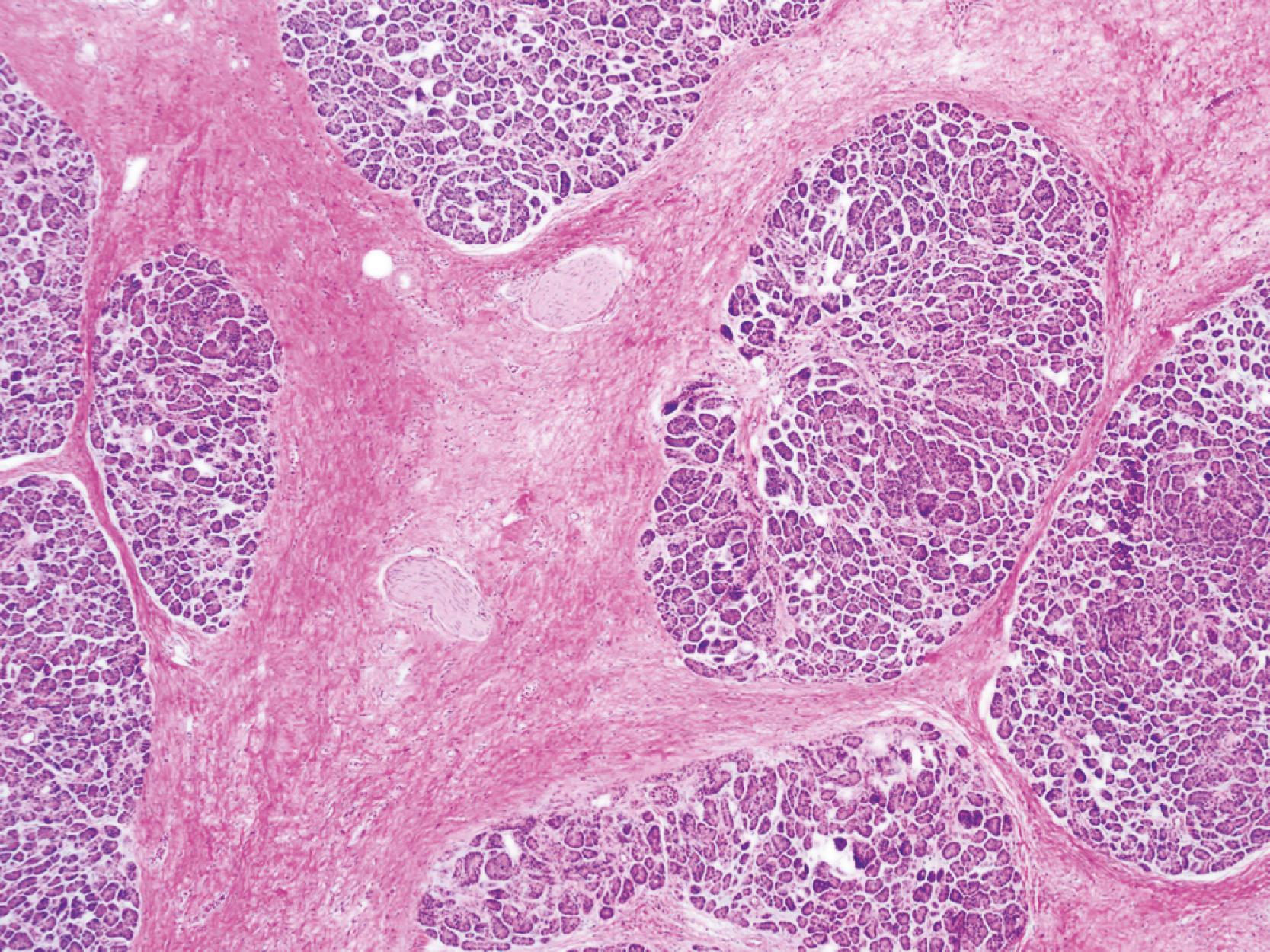
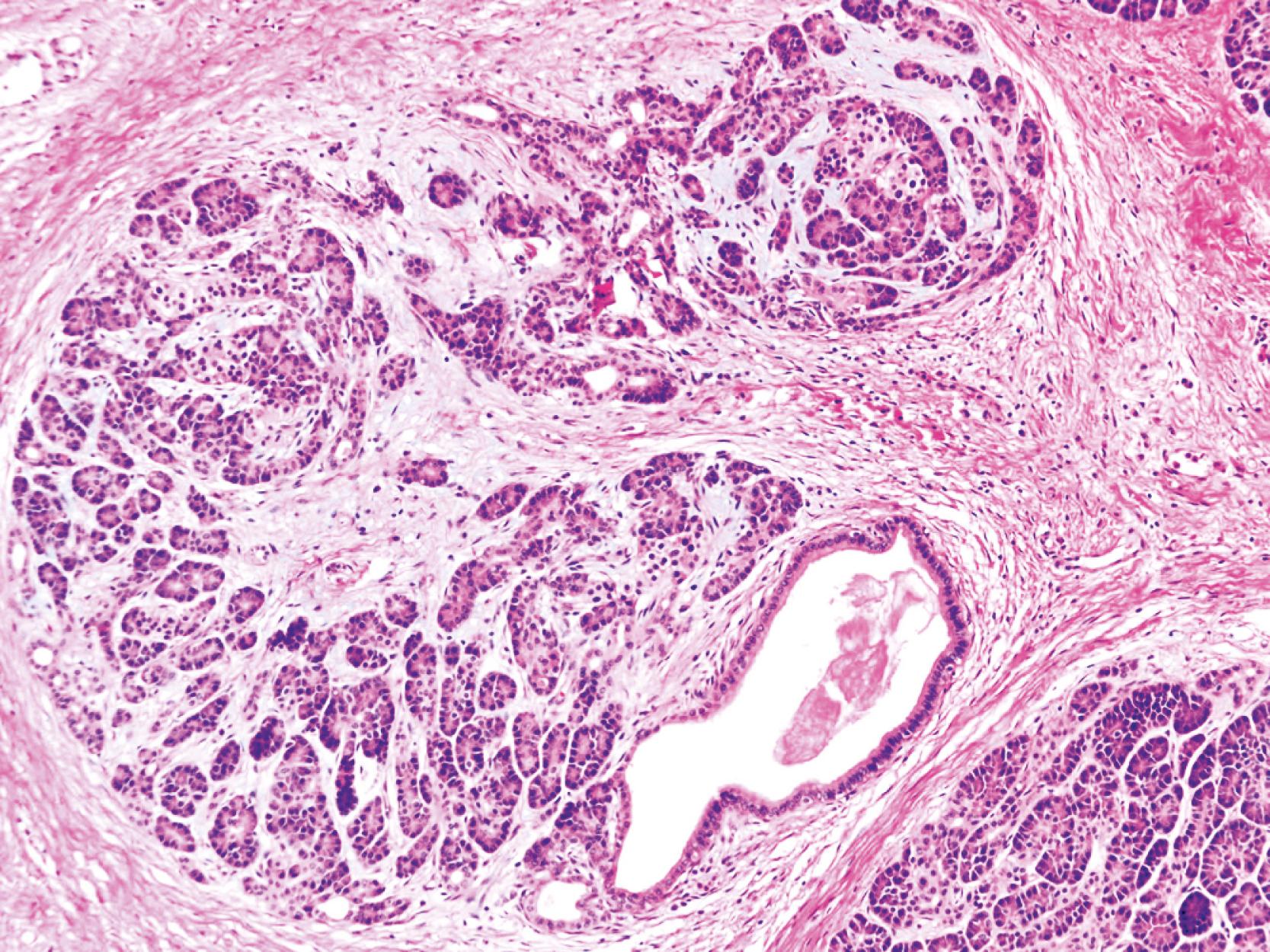
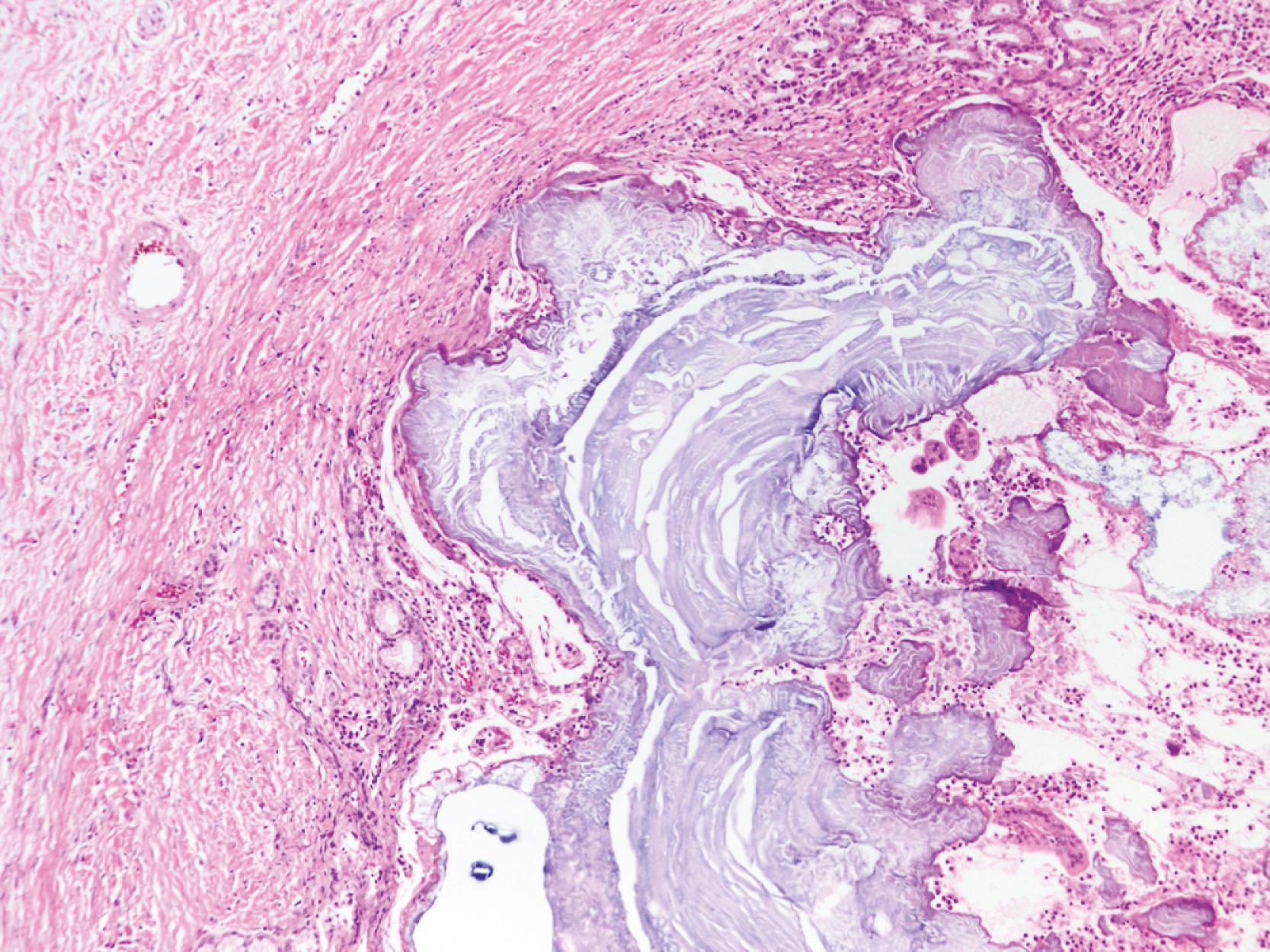
An inflammatory component is invariably identified, but the degree of inflammation is significantly less than that seen in AIP. Most of the inflammatory cells are small lymphocytes, and lymphoid aggregates are also occasionally present. The inflammatory infiltrate often surrounds peripheral nerve twigs. Plasma cells are usually inconspicuous. In contrast with AIP, periductal lymphocytic accentuation is rarely identified. Intraneural and perineural lymphocytic aggregates are usually prominent. The small lymphocytes are predominantly T cells, although scattered B cells are also present. When neutrophils are identified, they are usually seen adjacent to pseudocysts and residual foci of acute pancreatitis; intraductal aggregates of neutrophils are uncommon.
In the early stages of chronic pancreatitis, the islets of Langerhans are usually normal in appearance. In the late phase, the pancreatic islets may appear remarkably prominent. This apparent prominence of the endocrine component is primarily related to the preferential loss of acinar tissue. It may occasionally be difficult to distinguish this “pseudohypertrophy” of the endocrine component from a pancreatic endocrine microadenoma. Immunohistochemical stains for insulin and glucagon can assist in making this distinction: pseudohypertrophic islets show an intimate admixture of insulin- and glucagon-producing cells, whereas a microadenoma is entirely negative for both markers or may show diffuse reactivity for glucagon. Ductular-insular complexes may be seen, but this is a relatively nonspecific finding. In the very late phase of the disease, there is an appreciable decrease in the endocrine component.
Lesions of pancreatic intraepithelial neoplasia (PanIN) are frequently identified in resections from patients with chronic pancreatitis. Most of these are low grade (grade 1 and grade 2); PanIN3 lesions are distinctly uncommon. The risk of carcinoma in the setting of chronic pancreatitis is discussed later.
Distinguishing a well-differentiated pancreatic adenocarcinoma from chronic pancreatitis can be one of the most difficult decisions a pathologist encounters. Making this distinction on the basis of a frozen-section or needle biopsy specimen exponentially increases the level of difficulty. Attention to the following four features is key to making the distinction of benign ducts from ductal neoplasia ( Table 40.1 ).
| Chronic Pancreatitis | Invasive Ductal Adenocarcinoma | |
|---|---|---|
| Lobular architecture maintained | Yes | No |
| Nonlobular distribution of glands | No | Yes |
| Nuclear variation >4:1 within a gland | No | Yes |
| Nuclear membrane irregularities | No | Yes |
| Cytoplasm | Frequently dense, eosinophilic | Frequently pale, vacuolated |
| Perineural invasion | No | Yes |
| Association of ducts with arteries | No | Yes |
As a general rule, ducts organized in well-circumscribed lobules are benign, whereas atypical ducts scattered in the interlobular septa or suspended within peripancreatic fat are concerning for a malignant process ( Fig. 40.6 ). Glands located within lobules, regardless of the degree of atypia, should suggest a “benign” interpretation ( Fig. 40.7 ). Other than an occasional large-caliber duct, ducts within the interlobular septa should be viewed with suspicion. Furthermore, unlike ducts in the liver, those in the pancreas do not accompany arteries, so the presence of a duct adjacent to an artery is highly suspicious for a pancreatic adenocarcinoma. The presence of perineural invasion is diagnostic for carcinoma, although it is important to ensure that the gland is actually infiltrating the perineural space. An additional caveat of significance is that pancreatic islets may be identified adjacent to islets. Vascular invasion is also diagnostic for carcinoma. Of note, veins may be inconspicuous on hematoxylin and eosin stain. An elastic stain greatly increases the sensitivity and specificity for detecting venous invasion.
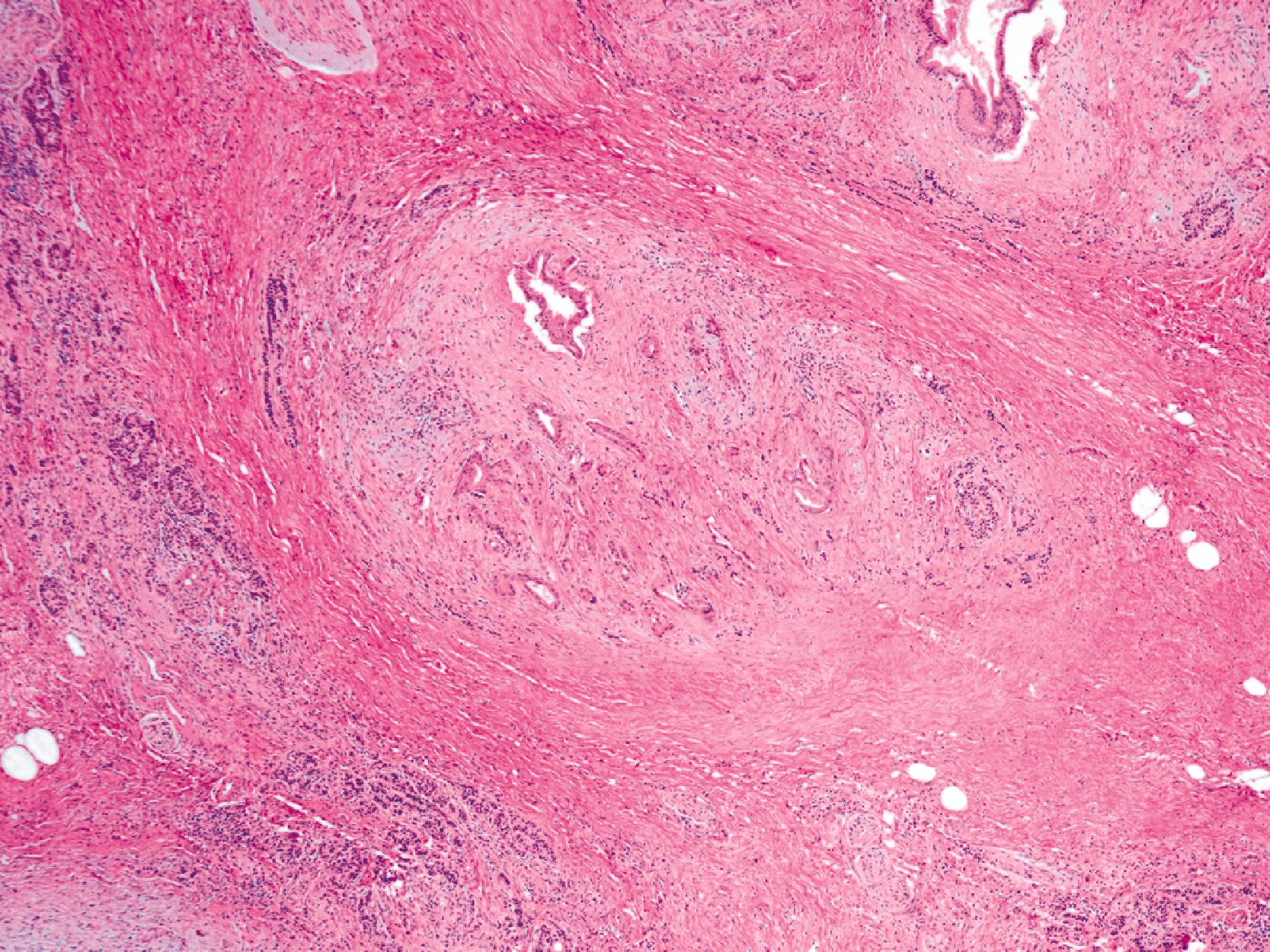
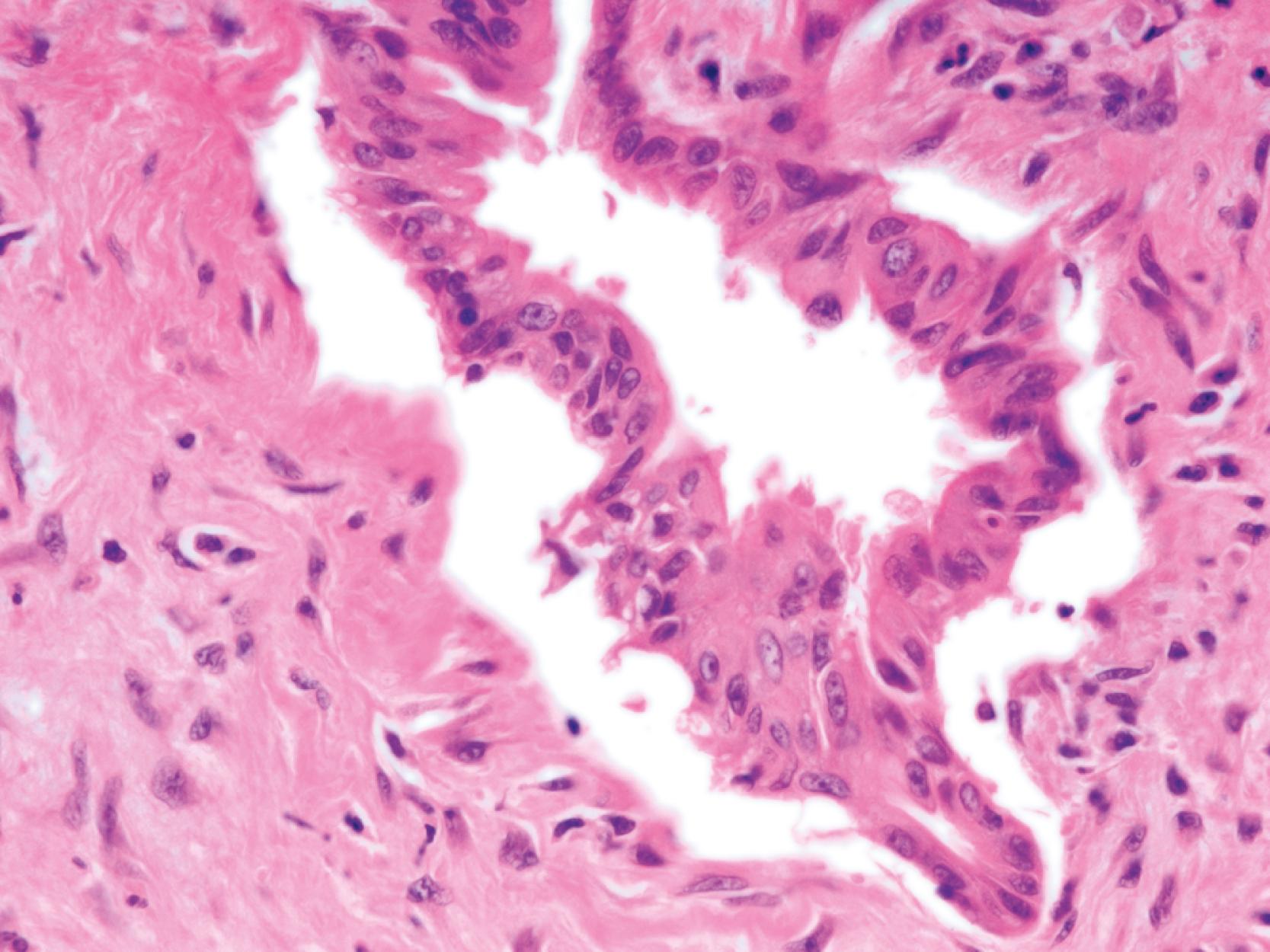
The desmoplastic reaction, a peculiar mesenchymal proliferation composed of fibroblasts suspended within a basophilic stroma, is an important feature of ductal adenocarcinoma. However, distinguishing desmoplastic stroma from the stroma of chronic pancreatitis can be quite subjective.
The identification of cytoplasmic features is underemphasized in the diagnosis of malignancy. Benign ducts show a dense eosinophilic cytoplasm, whereas many (but not all) adenocarcinomas, especially the well-differentiated carcinomas, show abundant pale cytoplasm, giving the cells a low nucleus-to-cytoplasm (N:C) ratio. A low N:C ratio is a common finding in pancreatic ductal adenocarcinoma.
The two most reliable nuclear features of pancreatic ductal adenocarcinoma are markedly irregular nuclear outlines and anisonucleosis (>4:1 variation in nuclear size), the latter within a glandular unit. The variation in nuclear size is appreciable on paraffin and frozen sections, but the nuclear irregularities are less obvious on these preparations. Both features, however, are reliably identified on cytology preparations.
A number of immunohistochemical and molecular markers can help with this distinction, and these are covered in great detail in Chapter 41 .
The type 2 variant of AIP is most likely to be confused with alcoholic chronic pancreatitis. The two hallmarks of type 2 AIP (a dense periductal lymphoplasmacytic infiltrate and granulocytic epithelial lesions) are seldom seen in alcoholic chronic pancreatitis. It is important to emphasize that type 2 AIP is not an immunoglobulin G4 (IgG4)-related disease and is not associated with elevated serum or tissue levels of IgG4, although mild elevations may be seen. An immunohistochemical stain for programmed death-ligand 1 (PD-L1), expressed by involved ducts in type 2 AIP, may assist in this distinction (see later in this chapter).
In contrast, distinguishing the type 1 variant of AIP from alcoholic pancreatitis is relatively straightforward. Histologically, virtually all cases of type 1 AIP demonstrate a triumvirate of histological features: (1) a dense and diffuse lymphoplasmacytic infiltrate, unlike the patchy lymphocytic infiltrate of alcoholic pancreatitis; (2) storiform-type fibrosis, unlike the acellular fibrosis of chronic alcoholic pancreatitis; and (3) obliterative phlebitis. Furthermore, almost all cases of type 1 AIP show greater than 50 IgG4-positive plasma cells per high-power field (HPF). However, difficulties arise when interpreting needle biopsy specimens. Patchy involvement of the pancreas is common, and some biopsies may not demonstrate the full spectrum of histological findings. In such cases, correlation with clinical and radiological features as well as serum IgG4 levels is required.
Chronic pancreatitis has consistently been shown to be a risk factor for pancreatic cancer. One of the concerns with many studies evaluating the association between chronic pancreatitis and pancreatic carcinoma is the potential for misdiagnosis of pancreatic cancer as chronic pancreatitis, which inflates the risk of malignancy. However, even after excluding cancer within in the first 2 years following the diagnosis of chronic pancreatitis, the risk of pancreatic cancer is elevated 16-fold. Notably, the risk declines over time, but is still eightfold increased when the analysis is limited to cases that are greater than 5 years from the diagnosis of chronic pancreatitis. In comparison with chronic alcoholic pancreatitis, hereditary pancreatitis carries a far higher risk of pancreatic cancer (approximately 35% during a lifetime).
The goals of treatment are to relieve pain, prevent recurrent attacks of acute pancreatitis, and manage the metabolic consequences such as maldigestion and diabetes. Surgery or endoscopic intervention is required to relieve intractable pain or to address specific complications such as pseudocysts. The objective of surgery (pancreatojejunostomy) is to decompress the pancreatic duct (which relieves pain) and to preserve as much of the pancreas as possible (to preserve pancreatic islets).
There is growing evidence that a significant proportion of patients with apparently idiopathic recurrent acute or chronic pancreatitis have underlying genetic abnormalities. Among the genes that predispose an individual to chronic pancreatitis, three are associated with defects in the activation of trypsinogen: PRSS1, SPINK1, and chymotrypsin C (CTRC). This is not surprising because one of the fundamental events in the development of pancreatitis is the activation of trypsinogen to trypsin ( Fig. 40.8 ). Trypsin is associated with some unique enzymatic features because it can both self-activate and deactivate itself. The mutations in PRSS1 that are associated with the development of chronic pancreatitis either cause premature activation of this enzyme or abrogate the inactivation. The most common mutation in PRSS1, R122H, abrogates the ability of trypsin to inactivate itself and also enhances trypsinogen autoactivation. The SPINK1 gene encodes for a trypsin inhibitor, and loss-of-function mutations of this gene abrogate the ability of the protein to inhibit activation of trypsin. Other genes implicated in chronic pancreatitis are calcium-sensing receptor, such as calcium-sensing receptor (CASR), Claudin-2 (CLDN2), CTRC, and CFTR . The PRSS1 gene carries an 80% penetrance, while that for most other genes is less than 1%. It should be noted that in many cases, hereditary pancreatitis is a complex multigene and a multifactorial disease, one that includes gene-environment interactions and interactions among various pathogenic gene variants.
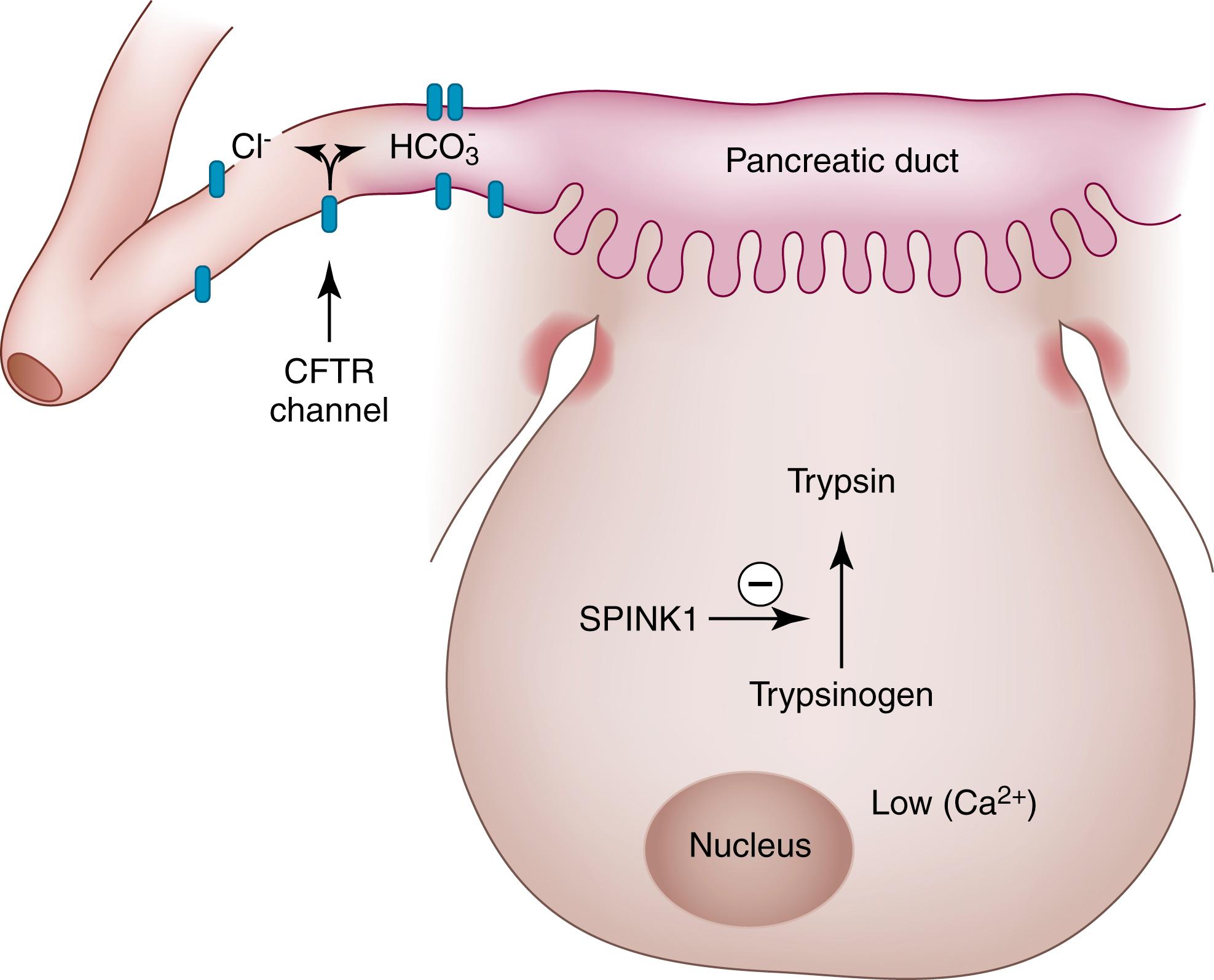
With rapid advances in technology, it is relatively easy to identify mutations in genes that contribute to the development of pancreatitis. Although mutations in each of these genes have unequivocally been linked to pancreatitis, many of the mutations are disease-neutral, and some could even be protective. Furthermore, the penetrance is extremely low—in some cases, less than 1%. Therefore the interpretation of these genetic tests is complex. With some exceptions (discussed later), testing for mutations in unselected patients with suspected pancreatitis is not recommended.
Current guidelines, based largely on expert consensus reviews, recommend the use of genetic testing in the following individuals: (1) recurrent acute pancreatitis or chronic pancreatitis of uncertain cause, (2) idiopathic chronic pancreatitis in individuals younger than 25 years of age, (3) family history of idiopathic chronic pancreatitis, or recurrent acute pancreatitis, and (4) at-risk family members of individuals with a positive pathogenic mutation.
Since the discovery of the PRSS1 gene, more than 20 mutations have been identified ( Fig. 40.9 ). The clinical relevance of the R122H mutation is supported by data from a transgenic model. Gain-of-function mutations, especially R122H and N29I, show a high penetrance (80%). This, coupled with the increased risk of pancreatic cancer (35-fold), supports the use of diagnostic testing for these mutations in young patients with acute or chronic pancreatitis.
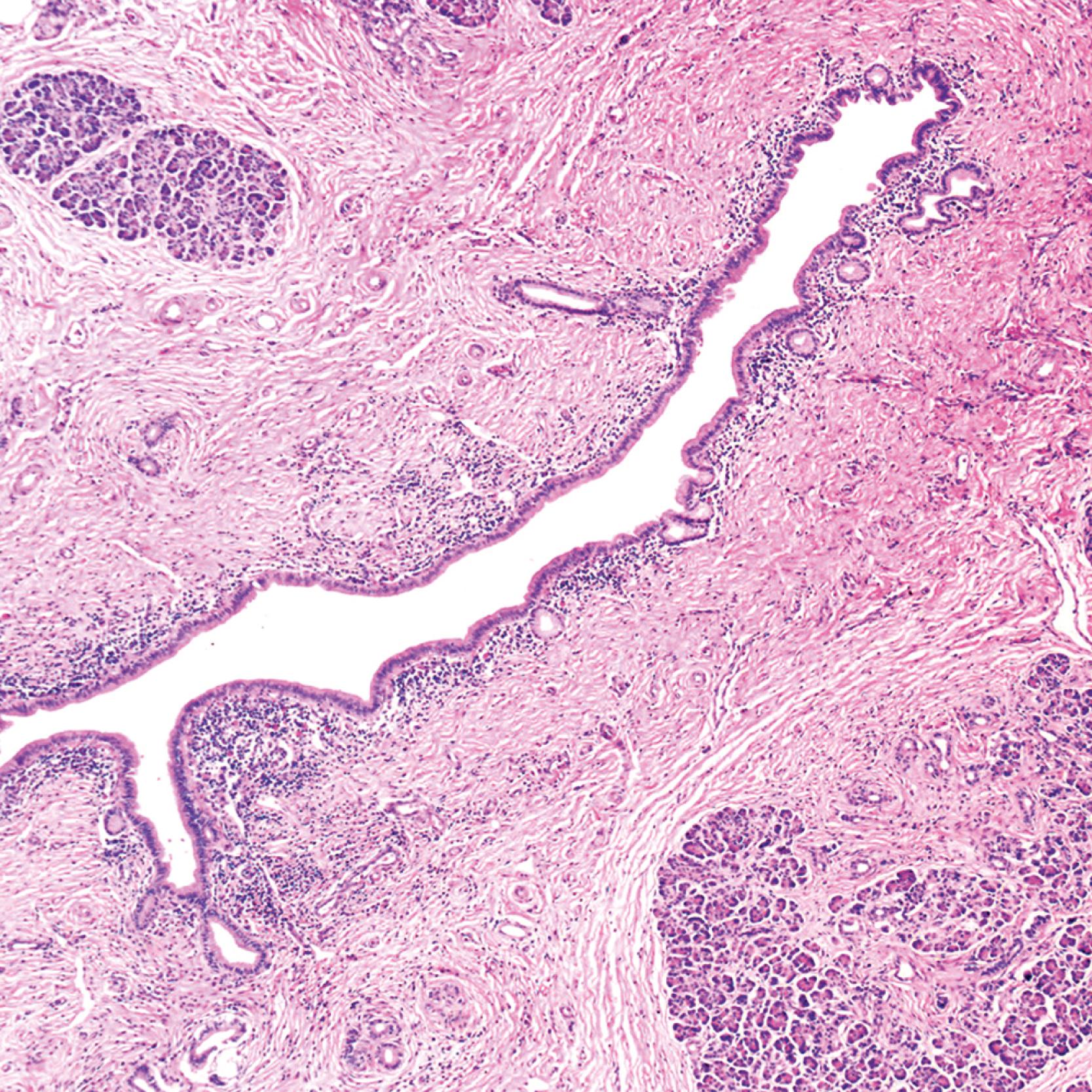
The enzyme protects the pancreas against premature trypsinogen activation. The most common SPINK1 mutation, N34S, has a high frequency (approximately 2%) in the general population and is associated with a very low disease penetrance. Less than 1% of heterozygous SPINK1 carriers develop chronic pancreatitis in the absence of other contributory factors. Consequently, SPINK1 mutations are thought to be disease predisposing or disease modifying rather than directly causing disease. Homozygous or compound heterozygotes for SPINK1 leads to an autosomal recessive form of chronic pancreatitis that may be phenotypically similar to PRSS1 mutation carriers. Compound heterozygotes for SPINK1 and CFTR are associated with early onset and more aggressive pancreatitis. Alcohol may precipitate episodes of acute pancreatitis in individuals with SPINK1 mutations. Little is known about the histological features associated with SPINK1 mutations.
Cystic fibrosis–related pancreatitis is caused by alterations of the CFTR gene and varies greatly in its severity. The association between CFTR mutations and chronic pancreatitis was first identified more than two decades ago. The CFTR gene encodes an anionic channel and is involved in chloride and bicarbonate secretion in the ductal cells of the pancreas, among other organs. In one study, 43% of patients with idiopathic recurrent acute pancreatitis and 11% of patients with chronic pancreatitis carried CFTR mutations in one or both genes. F508 mutations account for approximately 40% of CFTR variants in patients with hereditary pancreatitis.
Although chronic pancreatitis develops in a substantial majority of patients with cystic fibrosis, a small but distinct group of mutations is associated with isolated involvement of the pancreas (i.e., without pulmonary and other typical manifestations). The mutations seen in this setting are distinct from those associated with cystic fibrosis, and the patients typically do not show other clinical features of cystic fibrosis. Furthermore, their sweat chloride levels are normal. , , Unlike patients with cystic fibrosis, these patients are diagnosed in adulthood.
Morphologically, in addition to fibrosis, patients with CFTR genetic alterations show ductal protein plugs.
This is an uncommon cause of chronic pancreatitis, accounting for fewer than 2% of all cases. Hereditary pancreatitis is an autosomal dominant disease that typically manifests with recurrent attacks of acute pancreatitis in childhood, typically in the first and second decades of life. A diagnosis of hereditary pancreatitis should be suspected in any individual in whom chronic pancreatitis develops at an early age (<25 years). The disease affects men and women equally.
In 80% of cases, hereditary pancreatitis is caused by a gain-of-function mutation in the PRSS1 gene (see earlier discussion). Although 20 mutations have been identified, the 2 most common mutations are R122H and N29I . The penetrance of these mutations is high, and approximately one-half of these patients progress to chronic pancreatitis. The estimated cumulative risk of pancreatic cancer to 70 years of age in patients with hereditary pancreatitis approaches 40%. The type of genetic mutation does not correlate with the risk of cancer.
The disease is characterized by fatty replacement of the pancreas. Fibrosis, typically mild, is significantly less than that seen in alcohol-related chronic pancreatitis. Periductal inflammation may be observed. In older patients, PanIN is often seen.
During development, the dorsal and ventral pancreatic ducts fuse, with the major pancreatic drainage occurring through the duct of Wirsung (the ventral duct), with little or no drainage through the duct of Santorini (the dorsal duct). In about 10% of the population, the duct of Santorini and duct of Wirsung fail to fuse, a condition referred to as pancreatic divisum.
Three forms of pancreatic divisum are recognized: (1) type 1 or classic pancreatic divisum, characterized by complete absence of communication between the ducts of Wirsung and Santorini (70% of cases); (2) type 2 (25% of cases), defined by the complete absence of the duct of Wirsung, with the entire drainage occurring through the duct of Santorini and the minor papilla; and (3) type 3 (5% of cases), characterized by a narrow and inadequate communication between the ventral and dorsal pancreatic ducts.
Most individuals with pancreatic divisum are asymptomatic, and pancreatitis develops in only a minority of patients. The disease manifests primarily in adults, and both sexes are affected. Pancreatic disease in the form of acute or chronic pancreatitis is in part caused by inadequate pancreatic drainage through a narrow dorsal pancreatic duct. Endoscopic retrograde cholangiopancreatography (ERCP) often reveals a short ventral duct and a main pancreatic duct that communicates with the dorsal duct and drains into the duodenum near the minor papilla.
One of the most controversial aspects of this disease is the difficulty in demonstrating a causal relationship between pancreatitis and this anatomical variation of the ductal system. There is increasing evidence to suggest that pancreatic divisum alone is insufficient to precipitate pancreatitis. Some studies have shown no difference in the prevalence of pancreatic divisum between patients with idiopathic pancreatitis and a control population, 5% and 7%, respectively. However, this group of authors also found that the prevalence of pancreatic divisum in patients with pancreatitis and mutations in CFTR, SPINK1, or PRSS1 was 47%, 16%, and 16%, respectively. Therefore only a small proportion of patients with pancreatic divisum would benefit from decompression of the dorsal pancreatic duct, a procedure that can be performed endoscopically. Histologically, the pancreas may show features similar to obstructive chronic pancreatitis.
AIP is a mass-forming inflammatory lesion of the pancreas that may mimic pancreatic carcinoma. It is only in the past two decades that this disease has received the attention it richly deserves. Previously, these cases were diagnosed nonspecifically as chronic pancreatitis. In retrospect, approximately 25% of pancreatic resections that lack histological evidence of malignancy may represent AIP.
AIP was first described by Sarles and colleagues in the 1960s. They described four cases of chronic pancreatitis in patients presenting with steatorrhea and obstructive jaundice. Histologically, the pancreas showed a dense lymphoplasmacytic infiltrate. Although the histological description was brief, it is likely that these cases represented AIP. Little progress was made in the subsequent 3 decades, although there were similar sporadic case reports in the literature. Kawaguchi and coworkers are credited with the first modern histopathological description of type 1 AIP. They described two men with obstructive jaundice and histological features that are now considered typical for AIP. The term autoimmune pancreatitis was coined by Yoshida and colleagues in a case report in 1995, and this term is now the preferred designation for this disease. ,
A major milestone in understanding of this disease came with the apparently serendipitous discovery of its association with elevated levels of serum IgG4. Shortly thereafter, it was established that the inflamed pancreas shows a substantial increase in IgG4-positive plasma cells. It was subsequently realized that a sizeable number of patients with AIP also exhibit either synchronous or metachronous fibroinflammatory mass lesions in other organs, including the liver and biliary tract. , This multifocal systemic fibroinflammatory disease is now termed IgG4-related disease. Notably, AIP is only one manifestation of IgG4-related disease, and in an attempt to highlight this relationship, some authorities advocate use of the term IgG4-related pancreatitis.
AIP is not a homogenous entity because the disease can be clearly segregated into two distinct clinicopathological subtypes: AIP type 1 and AIP type 2. , Type 1 AIP is the pancreatic manifestation of IgG4-related disease, whereas the type 2 variant is a distinct and non–IgG4-related disease. Although there is some overlap in the clinical and radiological aspects of these two variants (see later discussion), the two entities are biologically distinct, and some authors prefer to use the term idiopathic duct-centric pancreatitis when referring to type 2 AIP in an attempt to draw a clear distinction between the diseases. , ,
AIP is an uncommon disorder. A recent nationwide survey in Japan identified an overall prevalence rate of 45.1 cases per 100,000 patients, with a threefold increase in the number of cases during a decade. Although no data are available from North America, it is important to emphasize the fact that this disease is significantly less common than pancreatic carcinoma.
Both the gender ratio and the mean age at presentation vary according to the histological subtype. Patients with type 1 AIP tend to be older (in their seventies) than patients with the type 2 variant (in their fifties). , , , , , , Most patients with type 1 AIP are male, whereas the gender ratio for type 2 AIP is approximately 1:1. There is considerable overlap between the demographic and clinical features of alcoholic chronic pancreatitis and those of the type 2 variant of AIP, although the former entity tends to be more common in men.
There appear to be geographic variations in the incidence of the two subtypes: the type 2 variant is relatively uncommon in Asia but constitutes almost one-half of all patients of AIP in series from Europe and North America. , ,
Obstructive jaundice and weight loss are characteristic features of type 1 AIP. , , , , , These symptoms, along with a mass on imaging, make the clinical distinction of this disease from pancreatic ductal adenocarcinoma extremely problematic. Other nonneoplastic pancreatic lesions that mimic pancreatic cancer are listed in Box 40.3 . Other presenting symptoms of patients with type 1 AIP include fatigue and recent onset of diabetes mellitus. Some patients may complain of vague abdominal pain. Patients with type 1 AIP may have other manifestations of IgG4-related disease, either synchronously or metachronously, and the involvement of these organs represents one of the most valuable clues to the diagnosis of this inflammatory pancreatic disease. , , , , , One of the more common extra-pancreatic manifestations of type 1 AIP is a painless unilateral and, more often, bilateral swelling of the submandibular salivary gland. In fact, in an individual with painless obstructive jaundice, bilateral enlargement of the submandibular salivary glands is strongly suggestive of IgG4-related disease (AIP). Other sites commonly involved by IgG4-related disease include the biliary system, lung, kidney, and retroperitoneum.
Autoimmune pancreatitis, type 1 and type 2
Paraduodenal pancreatitis
Alcoholic pancreatitis (extremely uncommon mimic of carcinoma)
Lipomatous pseudohypertrophy
Adenomyomatous hyperplasia of the Vaterian system
Intrapancreatic spleen
Pancreatic hamartoma
Infectious pancreatitis-tuberculosis
Sarcoidosis
Patients with type 2 AIP often present with abdominal pain, although the pain is rarely severe enough to suggest acute pancreatitis. , , , , , In comparison with type 1 disease, a smaller proportion of patients with type 2 AIP have obstructive jaundice at presentation. The disease is confined to the pancreas, and extrapancreatic involvement is type 2 AIP.
Although AIP is an uncommon cause for either acute or chronic pancreatitis, more than 33% of patients with this disease have symptoms that mimic other forms of acute or chronic pancreatitis.
Elevated serum IgG4 is the most robust biomarker for this disease. , Elevated serum IgG4 is fairly sensitive (80%) for type 1 AIP, but its specificity, particularly in an unselected population, is low. , , In one survey, only 10% of patients with elevated levels of serum IgG4 had evidence of IgG4-related disease. An even more worrisome observation is that approximately 10% of patients with pancreatic cancer show elevated levels of serum IgG4. Further compounding this challenge is that the pretest probability of AIP is relatively low. Nevertheless, in general, the higher the serum IgG4, the more likely the patient has type 1 AIP. Thus specificity of this test is improved when the threshold is set at 280 mg/dL (two times normal).
Many other serological immunological abnormalities are identified in patients with AIP. These include positive antinuclear antibody, rheumatoid factor, and elevated gamma globulin levels. A variety of other antibodies have been identified, including antilactoferrin and anti–carbonic anhydrase antibodies, although these are not specific and are not used in clinical practice. ,
An autoantibody against a plasminogen-binding protein peptide, originally reported to be a highly specific and sensitive test for AIP, has been refuted by recent studies. ,
Patients with type 2 AIP only rarely show elevated levels of serum IgG4, and there is currently no reliable biomarker for the recognition of this variant.
During the past decade, radiologists have greatly improved their ability to identify AIP and distinguish it from pancreatic carcinoma.
On imaging, three patterns of AIP are recognized: diffuse, focal, and multifocal. The diffuse form of the disease ( Fig. 40.10 ) is the most common type; the pancreas appears enlarged and “sausage shaped.” Among these patterns, the focal form of disease is most likely to be confused with pancreatic carcinoma.

The affected regions of the pancreas are hypoechoic on ultrasonography and hypointense on CT. On contrast-enhanced CT, there is decreased enhancement of the mass in the arterial phase and delayed enhancement in the late phase. , A small, hypodense rim is often identified around the lesion—the so-called halo sign. On MRI, the pancreas is diffusely hypointense on T1-weighted images and slightly hyperintense on T2-weighted images. The main pancreatic duct is usually narrow, and upstream dilation of the pancreatic duct should raise concern for pancreatic carcinoma. Both the bile duct and the pancreatic duct may be narrowed (double duct sign), a feature that is otherwise suggestive of pancreatic carcinoma.
An irregularly narrowed main pancreatic duct is very characteristic of AIP ( Fig. 40.11 ). On ERCP, the following four features help distinguish AIP from pancreatic adenocarcinoma: (1) a long stricture involving more than one-third of the main pancreatic duct, (2) lack of upstream dilation, (3) side branches arising from a strictured segment, and (4) the presence of multiple strictures involving the main pancreatic duct. The presence of all four features is highly specific but only moderately sensitive for AIP. Although the Japanese and Korean diagnostic criteria are highly dependent on pancreatography, those published from the United States do not require imaging of the pancreatic duct.

Within 1 to 2 weeks of initiation of steroid therapy, there is a dramatic shrinkage of the mass with partial to complete normalization of the main pancreatic duct, a finding that helps reaffirm the diagnosis of AIP. In the late phase of this disease, the pancreas appears shrunken and atrophic.
The exposure of genetically susceptible individuals to environmental or intrinsic risk factors triggering a stereotypical orchestral immune reaction represents a likely pathogenetic mechanism for type 1 AIP. It is notable that unlike classic autoimmune diseases, type 1 AIP affects elderly men.
The strongest genetic risk relates to human leukocyte antigen (HLA), with minor associations involving polymorphisms of immune-related genes (e.g., CTLA4, FCRL3 ). , The genetic susceptibility factors that have been identified in the Japanese population include the HLA serotypes DRB1∗0405 and DQB1∗0401 .
T cells play a prominent role in IgG4-related disease. Although B cells and IgG4-positive plasma cells are often emphasized, the T cell is the dominant cell type in IgG4-related disease. Early observations suggested that T cells in type 1 AIP show a Th2 bias. In theory, Th2 cytokines such as IL-4, IL-5, and IL-13 could account for tissue and/or serum eosinophilia and elevated serum IgE levels, characteristic findings in patients with type 1 AIP. However, recent evidence suggests that the Th1 reaction is not fully suppressed and occasional T cells express IFN-γ, the latter a defining feature of Th1 bias. , Unlike classic autoimmune diseases in which regulatory immune pathways are suppressed, AIP shows an increased proportion of regulatory T cells (Tregs), both within tissue and peripheral blood. , IL-10 produced by Tregs may guide IgG4 class-switching. Recent studies have also implicated oligoclonal CD4+ cytotoxic T cells that secrete of IFN-γ, IL-1β, and TGF-β.
Recent studies on IgG4-related sialodacryoadenitis support a role for Tfh cells in IgG4-related disease. Tfh cells, a distinct subset of CD4+ T-helper cells, are involved in germinal center formation, B-cell differentiation, and antibody maturation; these processes are partly mediated by IL-4 and IL-21 produced by Tfh cells. Circulating Tfh2 cells are preferentially expanded in IgG4-related disease with their quantities positively correlating with the number of affected organs, disease activity scores, and serum IgG4 levels.
The role of B cells in the pathogenesis of type 1 AIP is highlighted by the observation that rituximab, a B-cell–depletion therapy, is effective for type 1 AIP. The expanded plasmablast population in patients with IgG4-related disease decreased on treatment. , , Plasmablast represents precursors of plasma cells. An analysis of the plasmablast B-cell receptor repertoire also noted the oligoclonal nature of this expansion. , Interestingly, the dominant clones vary between patients, and novel clones emerge on relapse. , ,
IgG4 is generally regarded as a noninflammatory antibody because of its relative inability to fix complement and its limited capacity to bind Fc receptors. A conformational change accounts for its antiinflammatory nature, the so-called Fab-arm exchange, wherein a pair of heavy and light chains are exchanged between two IgG4 antibody molecules. As a result of the unusual structural alteration, the antibody loses its ability to cross-link antigens and form large immune complexes. Collectively, IgG4 may be secondarily induced in type 1 AIP, and may represent an attempt to dampen excess inflammatory reaction. A recent murine model lends credence to this hypothesis.
Become a Clinical Tree membership for Full access and enjoy Unlimited articles
If you are a member. Log in here